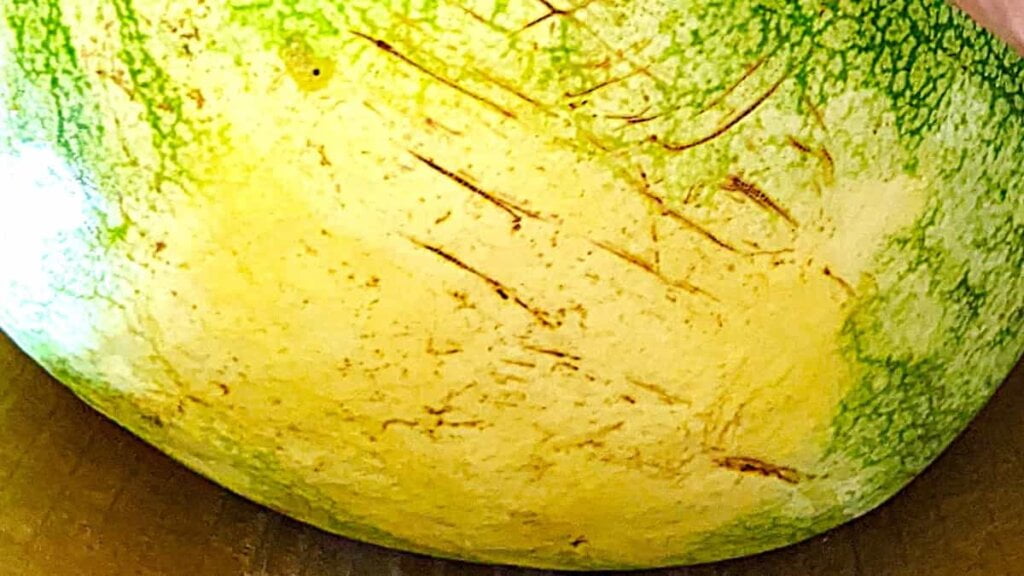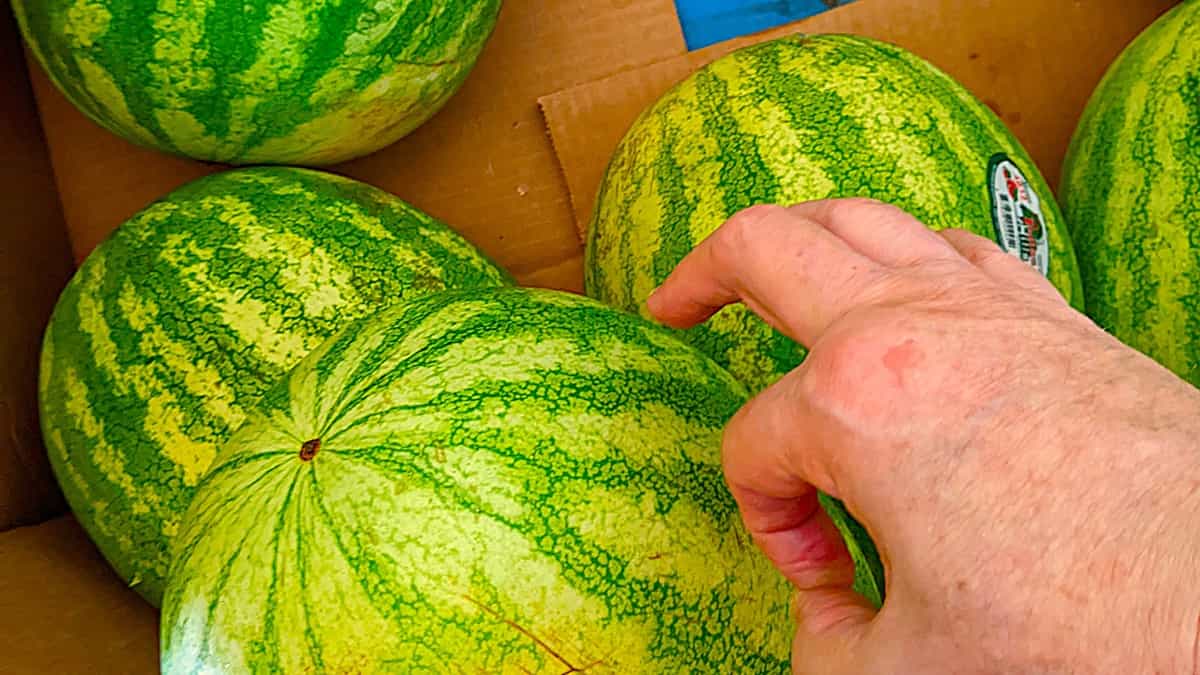This is a complete list of researched facts on how to pick a good watermelon. Read about all the popular clues, controversies, and myths. Also, this is listed in our Food Guides, Fruit, and Salads categories and our “How To Pick A Good Watermelon CHART” summary.
Overview of How To Pick A Good Watermelon
Everyone wants to know how to pick a good watermelon for the proper amount of sweetness, texture, and water content. Therefore, clues about it being underripe or overripen are extremely important. Overall, the selection clues will involve a combination of sight, feel, and sound. So, keep reading and I’ll go over each one of them.
3 Sections of Clue Areas of How To Pick A Good Watermelon
The 3 key sensory clue areas of how to pick a good watermelon involve what you see, feel, and hear. These are all mentioned next in just enough detail to easily understand each aspect.
Section 1. Visual Clues: What To Look For In A Good Watermelon
The best tips for confirming a good watermelon will be visual clues. Overall, here’s the list of what to see in a good melon.
- Shape (round is better)
- Stem or Stem base spot (should be brown)
- Field Spot (creamy color or yellow; not white)
- Darker green stripes is better
- Dull skin (not real shiny)
- Webbing is good for extra sweetness
Top Visual Clue # 1. Stem of Watermelon
The stem or stem spot should be brown overall. If it’s green or green and brown, skip that watermelon. This is a key factor in the selection process. The brown stem or stem base spot indicates the watermelon is ripe and has stopped growing. Often, the stem just falls off after this, leaving just the stem base spot, but not always.

The Stem or stem base spot should be fully brown. It’s located on one end of the watermelon. It indicates the watermelon was fully grown and ripe when picked.
Top Visual Clue # 2. Field Spot
Secondly, there should be a field spot. This is the area where the watermelon laid on the ground during ripening. Secondly, to ensure ripened enough, the field spot’s color should be creamy or yellow, not white. It can be slightly orange but if all orange, it might be too ripe.

The Field Spot should be a creamy, yellow, or a little orange color, but not white. However, if it’s overall dark orange, it may be overripe.
Top Visual Clue # 3. Shape of Watermelon
Overall, the better tasting watermelons are more round (female gender). A long or oblong shaped one (male gender) won’t be as good as spherical but still can be okay so, keep reading. More elongated watermelons will be more watery according to Eagle Eye Produce in their “How To Pick a Perfect Watermelon” post. Also, irregular shapes or bumps indicate to pick a different one.
So, size won’t matter. It’s the shape that matters. An overall even shape indicates it grew without stress.
Watermelon Stripes: Color & Pattern
The darker green watermelon stripes are best for color. If they’re a light or pale green, it’s not a good selection factor. Also, if the stripes have a readily defined pattern, that’s good too. However, broadly indefinable channels as stripes is not a good factor.

Darker GREEN watermelon stripes are more desired than pale or lighter green. This is a great factor.
However, other factors of a very inconsistent striping pattern and having a very elongated shape are negative factors.
Skin Appearance: Dull or Shiny
Absolutely choose the dull watermelon over the one with a glossy, shiny skin. However, if it has a mild sheen, that might be because the grocery store did that for an appearance. So, with a modest sheen, focus on the other factors to be sure. However, if it’s very shiny, it’s best to just skip that one.
Webbing and Sweet Spots
If you see a bunch of brown, vein-like webbing, that’s often very good. This is where sugar has been seeping out. So, it’s a strong sweetness indicator and is a huge positive clue. Brown spots indicate they are sugar spots, another example besides webbing. Both are a result of pollination performed by bees, for example.
Bad Spots: Black or White Specs
Avoid a watermelon with black or white specs that indicate belly rot and can make you sick. These are not to be confused with the dark brown sweet spots, however.
Scarring, Marks, and Gashes
These are not to be mixed up with webbing. Some scarring and marks can be acceptable. However, if there is a lot, then it might not have been handled very well. It might have internal concerns. Cuts and some scarring can be okay if there aren’t many. But, if a cut has some depth to it, consider that as a gash and skip the watermelon.

Small amount of mild scarring is acceptable. However, this is the max amount I would be okay with.
Two Finger Test
Some farmers will attest that the 2 finger test is the only factor you need. Others will differ. The idea is to place 2 fingers over a green stripe (parallel). If the width of the green stripe is equal to those 2 fingers, it’s a good, ripe watermelon.
Facts About The 2 Finger Test
- For one, people’s finger widths are very different.
- The second issue is that smaller watermelons will have smaller width stripes. It doesn’t mean that it won’t work for you; I’m just saying it’s not mathematically sound as an important factor.
- Finally, the National Watermelon Promotion Board says that watermelon stripes indicate the fruit’s variety, not its ripeness. Regardless, many people, including some farmers, still think the two-finger trick picks out the best watermelon.
Section 2. Tactile Clues: What Does A Good Watermelon Feel Like?
Overall, here are the tips to look for in feeling out a watermelon.
- Heavier is better, but only when comparing the same size.
- Press test should give a very slight giving inward.
- Obvious soft areas should be a rejection clue.
Watermelon Weight
When comparing watermelons of the same size, the heavier one is the better factor, as long as there are no soft areas.
Press The Watermelon for Soft or Hard Areas
A good watermelon will have a slight amount of give when you press on it. But, if it gives too easily, it might be overripe. Conversely, if it doesn’t have any give, it’s indicating not ripe enough.
If there are any obvious soft areas, skip it entirely.
Section 3. Other Sensory Clues: What Does A Good Watermelon Sound and Smell Like?
Thumping a watermelon can be deceiving. So, keep reading to understand the facts from the myths.
Sound Thumping a Watermelon: Least Important?
Tapping, slapping, knocking, or thwacking a watermelon is considered one of the top 3 tips everywhere. However, it’s partially a myth and partially true. The biggest problem is in how it’s explained and in how many interpret its sound. They always say to look for a deep, hollow sound. Unfortunately, an overripe watermelon also has a similar deep, hollow sound.

Tap a watermelon to listen for a deep, hollow sound. However, other factors are more important first.
So, thumping or tapping a watermelon is an advanced skill and is a low level factor that isn’t really necessary if you utilize the other clues. However, a good example is hold it like a baby and give a good open handed slapping thump on the top. If good volume of water, you’ll hear the deep sound but, more importantly, you’ll feel a healthy vibration in the lower supporting arm.
Smelling the Watermelon
An advanced watermelon test is to check the smell of the outer rind. If you have a mild aroma, it’s a good indicator. If you have a strong odor, it might be overripe. Conversely, if there’s no aroma, it might not be fully ripened yet.
Storing Your Watermelon
Keep your uncut watermelon at room temperature if you want. I will put mine in the fridge at least the night before I’m going to cut into it. Then, after I cut up the watermelon, I’ll ensure it’s store in a sealed food container or baggie. The larger uncut portion of the rest of the watermelon can be stored in a large bread bag or wrapped in food plastic wrap. Sometimes, I’ll also leave it on a plate to catch any juices.
Will an Underripe Watermelon Get More Ripe at Home?
The experts say No. Once the watermelon has been removed from the vine, it ends the ripening process. However, it does continue to age but that’s not the same.
Freezing Watermelon
The only time I would freeze watermelon if those precut pieces are going to be used in a smoothie. Another consideration might be for some other frozen dessert. Personally, I don’t ever freeze watermelon.
How Long Does Cut Watermelon Last in the Fridge?
I usually get a max of 2-3 days storage for watermelon cut pieces. After that, the texture deteriorates fast. So, that’s why I only cutup usually what we’ll use in 1-2 days. The bulk remaining uncut watermelon, if wrapped up properly, will last another 2 weeks easily.
Concluding Thoughts on How To Pick A Good Watermelon
Mastering the art of how to pick a good watermelon takes a bit of practice. So, when shopping, it’s good to look them over for honing that skill, even if not ready to pick one out. You now know the top clues on how to choose a great watermelon. Firstly, you’ve learned having an evenly, round shape is the first clue. Secondly, you’ve learned that the tail needs to be brown. Thirdly, you know the big field spot should be a creamy color with a lot of yellow and no white. Finally, all the other factors are a consideration after those first 3 are achieved. So, go practice now!

